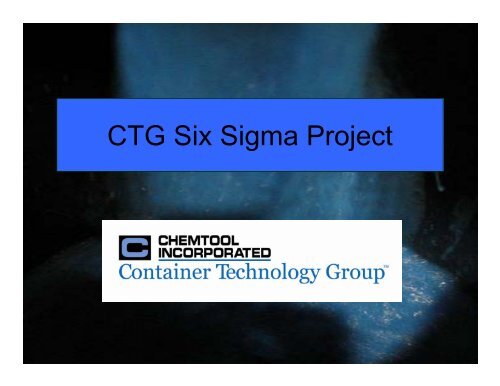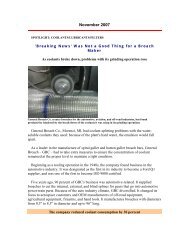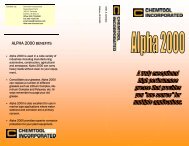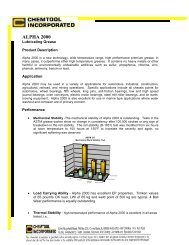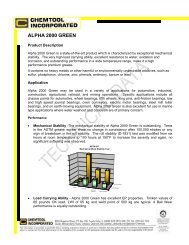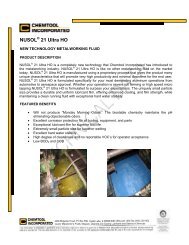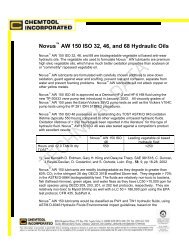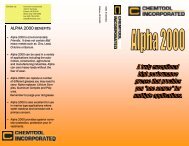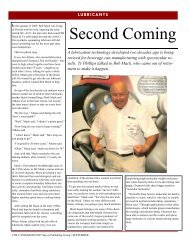CTG Six Sigma Project.pdf - Chemtool
CTG Six Sigma Project.pdf - Chemtool
CTG Six Sigma Project.pdf - Chemtool
You also want an ePaper? Increase the reach of your titles
YUMPU automatically turns print PDFs into web optimized ePapers that Google loves.
<strong>CTG</strong> <strong>Six</strong> <strong>Sigma</strong> <strong>Project</strong>
PURPOSE / DISCUSSION<br />
• The purpose of the study was to follow-up of the trial of<br />
Nusol 177-M cupper lube at a typical can-making plant<br />
as part of a <strong>Six</strong> <strong>Sigma</strong> study to reduce tear-offs. The<br />
tear of rates, while statistically reduced, did not show the<br />
major improvements seen at other locations.<br />
• The overall average T/O rate for a seven day time period<br />
(3/22 - 3/28/07) that the plant has experienced (both<br />
cuppers converted) running <strong>Chemtool</strong> 177M is<br />
0.128/10M.<br />
• The seven day T/O rate prior to the start of this trial (3/13<br />
- 3/19/07) was 0.147/10M.<br />
• At this point, the <strong>Chemtool</strong> product does show<br />
statistically valid improvement in T/O rates with an<br />
overall 12.5% reduction for the two time periods (see the<br />
Two Proportions Analysis below).
Test and CI for Two Proportions<br />
(C1A vs. 177M)<br />
• Sample X N Sample p<br />
• C1A 758 52348754 0.0000147<br />
• 177M 648 50466446 0.0000128<br />
• Difference = p (1) - p (2)<br />
• Estimate for difference: 1.639595E-06<br />
• 95% lower bound for difference:<br />
4.409649E-07
Test for difference = 0 (vs > 0): Z =<br />
2.25 P-Value = 0.012<br />
• It appears that the cup conveyor mat is a major factor in<br />
the MEMP tear-offs. When either line backs up, cups<br />
accumulate in ‘dead spots’ on the cup conveyor, and the<br />
conveyor continues to run. This leads to a situation<br />
where the cup lube can be physically removed from the<br />
cup exterior. The plant confirms that when there are<br />
extended down periods (1-2 hours), they dump the cups<br />
(6000 cans) rather than fight the F/E issues. This ‘root<br />
cause’ naturally affects product performance as well.<br />
Cupper 2 appears to have more inherent issues than<br />
Cupper 1 (missing cup elevator pins, heel dents, lower<br />
cup lube weights), yet consistently has better tear-off<br />
performance. This appears to be due to more consistent<br />
running, with fewer back-ups. The 12 B/Ms of line 2 (vs.<br />
10 on line 1) contribute to more consistent running as<br />
well.
The corrective action(s) would<br />
appear to be as follows:<br />
• Variable speed cup conveyor drives<br />
• Sensors to modulate drives<br />
• Auto-stop the cup conveyors on back-ups
Corrective Action Discussion<br />
• These steps were reviewed with plant personnel, and<br />
they indicated that corrective action would occur. Given<br />
the plant’s excellent TO rate, this will likely reduce them<br />
into single digits per million cans, even with the current<br />
product. <strong>Chemtool</strong> would expect to reduce that number<br />
even further, as has occurred at other locations, and<br />
pointed that out.<br />
• Some additional issues were raised, including<br />
“instability” in tramp levels and pH, inconsistent cup lube<br />
weights, and possible issues with can top wall<br />
concentricity. Excellent cooperation with Corporate <strong>Six</strong><br />
<strong>Sigma</strong> provided the plant with “data driven” answers to<br />
everything as follows:
Cup Lube Weights<br />
• The data summaries below indicate that the cup<br />
lube weights were actually more consistent<br />
during the NuSol 177-M trial than previously with<br />
the competitive product on line. <strong>Chemtool</strong><br />
identified major variations to the plant during the<br />
trial that led to solenoids being replaced on both<br />
Applicoaters, as well as a situation on cupper 1<br />
where the wick was not touching the bottom of<br />
the coil (exterior of the cup). These corrective<br />
actions certainly contributed to the improved<br />
consistency in the cup lube weights across the<br />
width of the cupper during the trial.
Cup Lube Weights (cont.)<br />
Cupper 1 - Overall Comparison<br />
Lube Mean StDev Minimum Maximum Range<br />
177M 15.631 3.488 6 26 20<br />
C1A 13.714 4.261 -12 20 32<br />
Cupper 2 - Overall Comparison<br />
Lube Mean StDev Minimum Maximum Range<br />
177M 16.167 2.924 8 27 19<br />
C1A 15 3.383 8 27 19
Coolant pH<br />
• Coolant pH increased to closer to 9.0 (avg)<br />
during the trial, which is difficult to rationalize as<br />
NuSol 177-M related (pH @ 20%<br />
concentration8.1-8.6). It should be noted the<br />
plant was running ‘trial’ Arco aluminum during<br />
this period, so some of the issues may be from<br />
that ‘noise’ as well.<br />
• Review of the data with the plant led to the<br />
admission the pH was in fact “more stable and<br />
capable” with NuSol 177-M.
Coolant pH (cont.)
• The table embedded<br />
below shows a<br />
precipitous reduction in %<br />
tramp, simultaneously<br />
with an increase in %<br />
cupper lube (177-M).<br />
Note: The data is from<br />
the plant QC testing. The<br />
same phenomena<br />
anecdotally occurs with<br />
C1 (higher cup lube<br />
weights increase the %<br />
cupper lube in the<br />
system, and the tramp oil<br />
level decreases).<br />
Tramp Level
Coolant Sample Results<br />
• A coolant sample was obtained from the Womack system and sent to the Crystal<br />
Lake laboratory for analysis. Results were:<br />
• Refractive Index FTIR<br />
• % NuSol 177-M 1.4% 2.1%<br />
• % Competitor EP 1.2% 2.3%<br />
• These results are consistent with the fact that no change was made to gear oil usage<br />
(~100 GPD), and that the plant added 80 gallons of Competitor EP to raise the level<br />
based on the QC results.<br />
• The <strong>Chemtool</strong> analysis uses a ‘salt split’ to separate the oil. The Competitors<br />
procedure uses Seaquest 100 to split the oil. An experiment was run with NuSol 177-<br />
M, Competitor EP, Seaquest 100, and the plants Brix refractometer. This showed the<br />
use of the Seaquest dramatically skewed the readings toward the % cupper lube. A<br />
50:50 tramp:cupper lube mix gave a reading of 70:30 when Seaquest was added.<br />
This same phenomena occurs with C1.
% NuSol® 177-M in Oil Split<br />
% NuSol 177-M in Oil Split (BRIX)<br />
NuSol 177-M = 5.26558 - 0.0652284 Brix<br />
S = 0.0120906 R-Sq = 99.9 % R-Sq(adj) = 99.9 %<br />
1.0<br />
NuSol 177-M<br />
0.5<br />
0.0<br />
65 70 75 80<br />
Brix<br />
NuSol 177-M can easily run in the same ranges as the competitor, and did in<br />
this trial, so keeping the cup weights in a 12-18 mg/cup range should not<br />
cause any future issues with the readings.
Concentricity<br />
• Analysis was done on midwall and topwall<br />
data for 3/13 - 3/19/07 (C1A) and 3/22 -<br />
3/28/07 (177M). The overall variability<br />
(can-to-can) that impacts random spoilage<br />
rather than BM specific concentricity<br />
(within can) that will also impact camera<br />
spoilage but is easily identified. The 2-<br />
variance chart below shows no statistical<br />
difference in the overall variances for<br />
these two time periods.
Connectivity (Cont.)<br />
Looking at the overall descriptive statistics of topwall (below), shows no differences.<br />
MEMP Concentricity Data Summary<br />
Variable Mean TrMean StDev Minimum Maximum Range<br />
C1A 0.006046 0.006045 0.000111 0.0056 0.00646 0.00086<br />
177M 0.006053 0.006053 0.000109 0.00567 0.00644 0.00077<br />
Again the data indicates less variation with NuSol<br />
177-M, and the plant acknowledged that.
SUMMARY<br />
• The plant rejected an Arco “test” coil on the<br />
afternoon of 3/29, and admitted to running ‘new’<br />
Arco plate for a ‘flatness’ issue. In spite of the<br />
trial coil rejection, running a metal having altered<br />
finishing passes, raising tramp levels above the<br />
ideal settings, cup conveying mat issues, the<br />
lower Applicoater injector solenoid falling three<br />
times and a 8.5 hour power failure that yielded a<br />
rash of T/O's upon plant restart, we have still<br />
seen a 12% improvement in T/O rates through<br />
3/28/07, and this will be reflected in the<br />
customer’s <strong>Six</strong> <strong>Sigma</strong> report on the trial.


